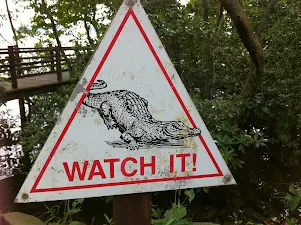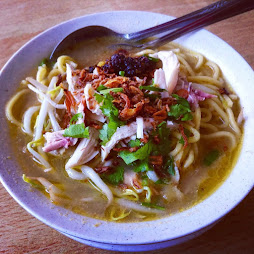Where can you find some wildlife apart from the zoo in urban Singapore? Sungei Buloh Wetland Reserve is located at the quiet remote corner of northwestern part of Singapore.
Buloh is a Malay word for bamboo. Buloh is also spelled as
buluh. And
Sungei means river. Therefore, Sungei Buloh means Bamboo River. Simply because it is located along Buloh River. Maybe there are many bamboos which grow in the area previously. You certainly can see some bamboos there.
The rich mangroves at Sungei Buloh were once used as a spawning location and nursery by prawn and fish farmers. Sungei Buloh Nature Park was designated a Nature Park in 1989 and the wetland reserve was officially opened in 1993 by former Prime Minister Goh Chok Tong. It was a protected forest reserve in 1890, though after 1973, during the industrialisation of Singapore, the mangroves around Kranji were cleared to make way for prawn, fish and horticultural farms and light industries. But since 2002, the 202 hectares of rich biodiversity of wetlands of mangrove swamps, mudflats, ponds and secondary tropical rainforests of Sungei Buloh has been protected back as a nature reserve. Sungei Buloh Wetland is a member of the
East Asia-Australasian Flyway Partnership and is Singapore's fist
ASEAN Heritage Park.
What do mangroves do? Though initially they are seen as wasteland and eyesores, mangroves are very important to the ecosystem. They contribute to soil formation and help to stabilise coastlines. They help to protect coral reefs and sea grass beds. They serve as a refuge and nursery for young fish, shrimps and crabs. Mangroves are natural spawning grounds for prawns and fish and are important in their life cycle. Mangrove trees also act as filters to prevent excess amount of nitrogen, phosphorous and other contaminants from entering the sea. More importantly for Sungei Buloh it provides a place for migrating birds to rest and feed as the mangroves produce leaf detritus that feeds fish, crabs, oysters and other marine life. Do you know that mangroves used to cover 13% of Singapore's land mass before 1819?
 |
| Sungei Buloh Wetlands |
There are many things to do and see at Sungei Buloh Wetland. It is a nature paradise for nature lovers. There is a 320 metres of migratory bird trail, and you may be able to spot some migratory bird species among the hides. Other than migratory shorebirds, Sungei Buloh is also home to many bird species, including bitterns,
kingfishers and other common water birds, like herons and
egrets. There are many types of herons and egrets, just like there are many types of bitterns and kingfishers (common, collared, stork billed, etc.).
Herons and egrets look similar, and one can easily get confused between the two. They both belong to the Pelecaniformes order which are waterbirds with long legs and necks. Grey herons are the second tallest bird here. They are generally grey with white feathers on its head, neck and underparts and they have black crest. Their bills and legs are yellow. All egrets have white plumage with black bill, black legs and yellow feet. Herons and egrets are sociable birds that nest together in colonies. You can also spot many herons and egrets at
Pasir Ris Mangroves Park. They can be normally spotted on the mudflats two hours before and after high tide.
 |
| Mangroves facing Johor Strait |
Do you know that the common redshank is the oldest recorded bird species at Sungei Buloh Wetland Reserve? If you are lucky, you can even spot a crocodile or two. The crocodiles here are the common tropical estuarine or saltwater species. Sungei Buloh Wetland rivalled
Pulau Ubin in terms of wildlife. So, we are fortunate to be able to appreciate nature right here in tiny Singapore.
Do not expect those big, huge crocodiles that we see on TV, but they are crocodiles, nevertheless. And the sight of them can still make one squirm especially when you realised they are quietly chilling just next to you. :) You can walk under the mostly shady trees to enjoy the wetlands. The shady trees help to mitigate the harsh humidity. You can go up the hide to see the bird's eye view of the reserve or to spot some birds like kingfisher, herons and egrets. At the hides there are educational boards to learn about the various types of birds.
 |
| Fantail pod among lush forest |
You certainly do not have to go to the Amazon jungle to enjoy the forest, the swamps, the
smooth-coated otters and the crocodiles or the caimans. There are boardwalks so you will not tramp on the fragile ecosystem. Ok, you can't find caiman here. Or the piranhas. They only exist in South America. You can see some piranhas in captivity at the River Safari at Mandai Zoo. Only male piranhas are kept here, to prevent breeding or accidental release into the wild. There is also dwarf caiman at Singapore Zoo.
Snakes, such as the venomous King Cobra, can be spotted at Sungei Buloh, as are spiders. As for monkeys, the long-tailed macaques, they are abundant at
MacRitchie Reservoir,
Pulau Ubin, at the
Southern Islands in particular the Big Sisters Island (Pulau Subar Laut), and at Bukit Timah nature reserves. So, for those who are afraid of monkeys, the quiet Sungei Buloh is the place as it is more of a shore bird paradise. Monkeys still can be spotted there though not in abundance. Maybe the crocodiles scare them away ;). The resident Long-tailed macaque is Felicia and her family and they may snatch food, bags and bottles from you, thus do not feed them.
 |
| Watch out for crocodiles! |
Monitor lizards breed very well at Sungei Buloh, you can see them in all sizes happily basking under the sun. Some
monitor lizards can be quite huge, but they are harmless so just leave them alone. The occasional smooth-coated otters have been spotted too, swimming just off the mangroves. The smooth-coated otter is the largest otter in South-East Asia and is named for its short, smooth coat which appears shiny and velvety. Well, you can now find otters just about everywhere now in Singapore, from
Pasir Ris and
Changi Beach to
Sentosa Island. Squirrels are common sighting too, but you can see squirrels in many parks in Singapore like the monitor lizards.
You can see from the scenic photos above and below that Sungei Buloh does resemble Amazon jungle. Just don't look too far out though while you are there as it will be Johor Bahru with their smoggy skyline. Sungei Buloh borders Malaysia with some water separating between us and our neighbour.
 |
| Migratory birds' sanctuary |
The best spot to see Malaysia is at Eagle Point observation fantod and the scenic boardwalk. There are fanpod observatories towers all over the reserve for shade and for looking out for wildlife. Both the coastal and the 90-metre long mangroves boardwalks are quite pleasant to walk and enjoy the sceneries. Many floras associated with mangroves can be found along the coastal trail like the Sea Holly. Sea holly is a plant that is associated with mangrove forest. This shrub has beautiful flowers and pointy leaves. In the past, villagers cooked the leaves of Sea Hollies for food.
Since the location is quite 'ulu' (remote), getting to Sungei Buloh is not so straightforward but that is the novelty of it. Most nature reserves here are away from the urban areas and are not served by MRT stations, not within walking distance. A few nature reserves like
Pasir Ris Mangroves Park and
Coney Island are walking distance from MRT or LRT stations.
 |
| Eagle Point overlooking Johor, Malaysia |
You can take bus #925 from Kranji MRT station and it stops near a carpark outside the reserve. You walk about 10 min from there to the reserve entrance. On Sundays and public holidays, the bus stops right in front of the Wetland Centre entrance. Its free entry all week long. So, you can indeed find calm and tranquility with nice sceneries right here in urban Singapore.
National Parks Board regularly organise free guided walks at Sungei Buloh so check out their website. Do check out their visitor centre too near the entrance and there are lots of information about the mangroves and the wildlife at Sungei Buloh. The gallery is very educational.
If you are into birding or nature photography, the migration of shorebirds to Sungei Buloh is quite remarkable. Just like at Pasir Ris mangroves park, you will find nature photographers with their bulky long-zoom lens and camouflage tees waiting patiently to capture some good shots.
 |
| Monitor lizards basking under the sun. |
Do you know that each year the birds migrate via ancestral routes such as the East Asian-Australasian Flyway to escape the harsh winter from the north from as far as Siberia and make their way to Sungei Buloh? These migratory shorebirds come every August to September and will fly off during springtime.
While you are at Sungei Buloh forest, lookout also for a rare mangrove tree called
Bakau Mata Buaya which literally means mangrove with crocodile eyes.
Buaya ia a Malay word for crocodile and
mata are eyes. This mangrove tree has a distinctive bumps on its roots which look like crocodile eyes, hence the name. This mangrove has only about 200 left worldwide, and Sungei Buloh has four of them!
You can find birds or photography enthusiasts with their camouflaged long zoom lens and camouflaged tees at the Singapore's Amazon jungle. To avoid crowds many people come during weekdays. The park is open from 7am to 7pm daily with the last entry at 6:30pm.










Comments
Post a Comment